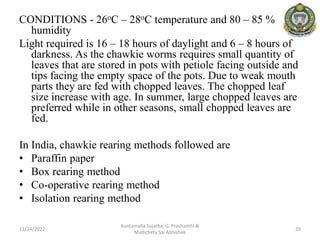
Imagine you’re trying to grow a lovely plant. You wouldn’t just leave it in any corner of your house, right? You’d want the right amount of sunlight, warmth, and moisture. Silkworms are similar—they need the right “home” environment to turn from eggs into those magnificent caterpillars that spin silk. Let’s explore how to create that perfect setting for your silkworms!
Understanding Silkworm Development Stages
Before diving into temperature and humidity specifics, it’s essential to understand the life cycle of silkworms. They go through several stages: egg, larva, pupa, and adult moth. Each of these phases has unique environmental needs.
– Egg Stage: The silkworm eggs are tiny and delicate. They require a stable environment to hatch successfully.
– Larval Stage: This is when the real fun begins! The larvae, or caterpillars, will eat a ton of mulberry leaves and grow rapidly. They need the perfect conditions to stay healthy and grow.
– Pupal Stage: After eating and growing, they’ll spin cocoons and enter the pupal stage, where they transform into moths.
Understanding these stages is crucial because each phase has different temperature and humidity requirements, which we’ll explore in-depth.
The Ideal Temperature for Silkworms
Temperature plays a huge role in silkworm development. Ideally, you’ll want to maintain a temperature range between 24°C and 28°C (75°F to 82°F) during the larval stage. If it gets too hot or too cold, the larvae can become stressed, leading to poor growth or even death.
– Too Hot: If temperatures rise above 30°C (86°F), it can be detrimental. Larvae may stop eating or even die, so keeping an eye on the thermometer is vital.
– Too Cold: On the flip side, if the temperature drops below 20°C (68°F), the growth rate slows significantly. Think of it like a car that’s running on low fuel—it’s going to move slowly!
Make sure to monitor temperatures regularly, especially during fluctuations in weather. Using a simple thermometer in the rearing area can help you keep track.
Humidity Levels That Support Growth
Humid conditions are just as critical for your silkworms as the right temperature. The ideal humidity level is between 60% to 70% during the larval stage. Maintaining this can be tricky, but here’s how you can do it:
– Too Dry: If the humidity level falls below 50%, the silkworms can dehydrate. Think about it—everyone feels sluggish in dry air, right? Your silkworms will too!
– Too Humid: Conversely, when humidity levels rise above 80%, there’s a risk of fungal infections. This is similar to how mold might grow in a damp bathroom. Keeping things balanced is key.
To manage humidity, you can use a hygrometer to measure levels accurately. If it’s too dry, consider misting the area lightly or placing a shallow pan of water nearby.
Creating the Perfect Environment
Now that you know the temperature and humidity needs, how do you create that ideal environment? It’s all about the setup!
1. Choose the Right Space: A well-ventilated room with minimal direct sunlight is ideal. Too much sun can heat things up too quickly.
2. Control Systems: Consider using a thermostat to automatically maintain the temperature. For humidity, you could use a humidifier or dehumidifier depending on your readings.
3. Regular Monitoring: Set up a routine to check both temperature and humidity daily. This way, if something goes off track, you can catch it quickly.
A well-planned environment can make all the difference in your silkworm rearing success.
Setting Up Your Rearing Boxes
When it comes to housing your silkworms, the rearing boxes matter. They should not only provide a safe space but also help manage temperature and humidity. Here are some tips:
– Insulation: Use materials that help insulate the box. Styrofoam or wood can help regulate temperature changes.
– Ventilation Holes: Ensure the boxes have ventilation holes to allow air circulation. However, avoid too many openings that might let humidity escape.
– Substrates: Use substrates that can retain moisture without becoming soggy. Materials like cotton or sponge can help with humidity control.
A well-thought-out rearing box can create a microclimate that’s beneficial for your silkworms.
Common Challenges and How to Overcome Them
You might face some common challenges when trying to keep your silkworms happy. Here are a few and how you can troubleshoot them:
– Temperature Fluctuations: If you notice the temperature bouncing around, try to move the rearing area away from drafty windows or heating vents.
– High Humidity: If humidity spikes, remember to ventilate the space. You can also reduce excess moisture by adjusting your watering routine.
– Low Growth Rates: If your silkworms aren’t growing as expected, double-check both temperature and humidity levels. Small adjustments can often do wonders!
Being aware of these potential issues will help you stay one step ahead.
Final Thoughts on Temperature and Humidity for Silkworms
In summary, creating the right conditions for silkworm rearing takes some thought and care. With a temperature range of 24°C to 28°C (75°F to 82°F) and humidity levels of 60% to 70%, your little silk factories will thrive.
Think of it like creating a cozy temperature for your favorite indoor plant or pet. Getting it right can yield amazing results, and before you know it, you’ll be harvesting silk and feeling proud of your handiwork.
Embrace the challenges, adjust as needed, and enjoy the journey of silkworm rearing! Your patience and care can lead to an incredible outcome. Happy rearing!
